 HOME >>
Artikelen >
HOME >>
Artikelen >
|
21 oktober 2022. Energetisch Onderzoek in Natuurgebied Springendal (Overijssel), naar aanleiding van de daar opgegraven vroegmiddeleeuwse schatvondst. |
|
Maja J. Kooistra. Verslag veldwerk 12 oktober 2022, 7 p. |
|
Lichtpuntjes |
|
Maja Kooistra In: HEUS 19 - 2022 p. 27. A3 boeken |
|
Onverwachte nieuwe perspectieven |
|
Maja Kooistra In: HEUS 14 - 2020 p. 19 t/m 21. A3 boeken |
|
Maja Kooistra, 2020. Koning der inheemse planten DE EIK. Symbool voor kracht en bescherming |
|
In: Feestelijke uitgave bij de tentoonstelling Diep geworteld. Bomen in de Nederlandse schilderkunst p. 37-38 Uitgave Bomenstichting en Dordrechts Museum, ter gelegenheid van het 50 jarig bestaan van de Bomenstichting, november 2020 |
|
Maja Kooistra, 2020. Koning der inheemse planten DE EIK. Wodanseiken een cultuurhistorisch portret |
|
In: Feestelijke uitgave bij de tentoonstelling Diep geworteld. Bomen in de Nederlandse schilderkunst p. 39-40 Uitgave Bomenstichting en Dordrechts Museum, ter gelegenheid van het 50 jarig bestaan van de Bomenstichting, november 2020 |
| Features related to faunal activity |
|
Kooistra, M.J. & Pulleman, M.M., (2018) In: Stoops, G., Marcelino, V. and Mees, F. (eds), Interpretation of micromorphological features of soils and regoliths, 2nd edition, chapter 16 - p. 447 - 471. Elsevier Science |
| De taxus |
|
Maja Kooistra en Annemiek van Loon (2016) In: Bomennieuws winter 2016. |
| Heggen op Bronstijdwallen in Dartmoor |
|
Maja Kooistra (2016) In: Stichting Heg&Landschap, Nieuwsbrief oktober 2016. |
| De kracht van populieren |
|
Maja Kooistra (2015) In: Wim Huijser en Henk Meeuwsen, 2015. Het ruisen van de populieren. Een requiem. Huijser & Meeuwsen, Wageningen. |
| 14th International Working Meeting on Soil Micromorphology |
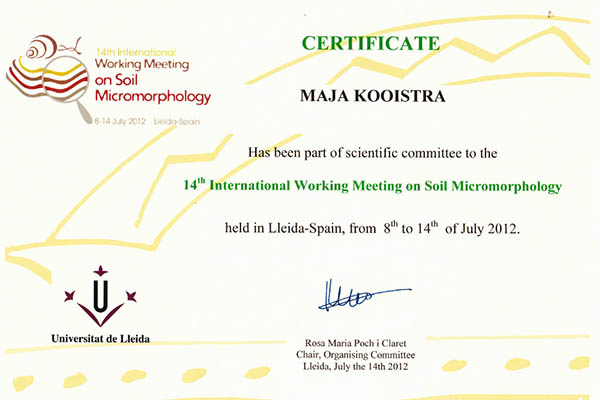
|
| Features related to faunal activity |
|
Kooistra, M.J. & Pulleman, M.M., (2010) In: Stoops, G., Marcelino, V. and Mees, F. (eds), Interpretation of micromorphological features of soils and regoliths, chapter 18 - p. 397-418. Elsevier Science Soil animals pass one or more active phases of their life cycle in the soil for different reasons, such as protection, feeding and reproduction. These organisms play an important role in transporting and altering various soil components, including organic matter decomposition and soil structure formation, and they thereby influence physical and chemical processes in soils. Faunal features are found in all types of soils, and the nature of entire soil horizons can be determined by faunal activity. There is a surprising lack of knowledge, however, on the precise functional roles played by many animals occurring in soils (Davidson et al., 2002). This chapter aims to provide a basic outline of the diversity of soil fauna, their activity in soils and the manner in which these affect micromorphological features in general terms. 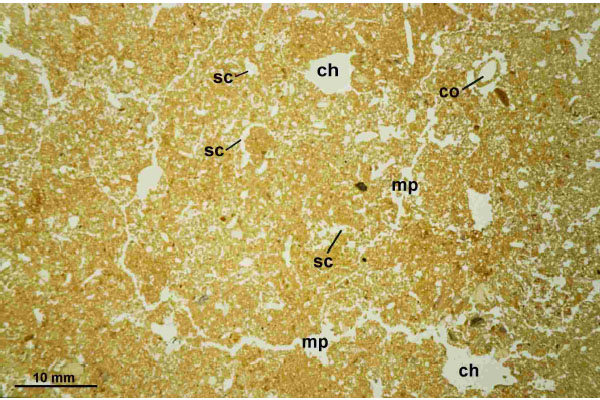
Fig 5. Different types of faunal void types in an alluvial plain soil (B-horizon, 65 cm depth, Uttar Pradesh, India) with a subangular blocky structure and a high earthworm activity: large irregular anecic earthworm channels (ch); modified planar voids (mp) and small channels inside the subangular blocky peds produced by endogeic earthworms and mesofauna (sc); excremental cocoon in a faunal channel (co) (PPL). (Image by M.J. Kooistra) |
| Eikenerfgoed in Nederland en Vlaanderen. Eikenbossen en eikenstoven in heden, verleden en toekomst |
|
Bastiaens, J., VandenBremt, P., Brinkkemper, O., Cosyns, E., Deforce, K., Keersmaeker, L. de, Kooistra, M.J., Leenders, K.A.H.W., Loon, R. van, Ludwig, H., Maes, N.C.M. (B), Mijnsbrugge, K. Vander, Tack, G., Vera, H., Zwaenepoel, A., 2010 Historisch-Geografisch Tijdschrift 28e jaargang no. 4: 115-140 Oude bossen zijn in de Lage Landen schaars geworden. Naar schatting kan minder dan 5% van de totale bosoppervlakte nog tot oude boskernen (ancient woodlands) waar autochtone bomen en struiken voorkomen, gerekend worden. In totaal gaat het naar ruwe schatting om slechts 15.000 ha. Het betreft veelal oud hakhout of strubbenbos. Met "autochtoon" worden in het geval van bomen de soorten bedoeld die in onze streken spontaan op eigen kracht gevestigd zijn na de ijstijd, of vóór 1850 met autochtoon plantmateriaal uit de streek aangeplant werden op oude bosplaatsen. In Nederland en in mindere mate in Vlaanderen, nemen de eikenbossen binnen de oude boskernen de belangrijkste plaats in. Hun overleving is met name te danken aan de eeuwenoude hakhout- en middelhoutcultuur en ze bestaan dan ook voornamelijk uit eikenhakhout. Door de veelzijdige producten die de eik leverde, zoals bouwhout, brandhout, schors als looistof voor leer en eikels als veevoer, was deze boomsoort tot aan het begin van de twintigste eeuw onmisbaar binnen ons economisch bestel. Een zeer klein percentage van de oude boskernen kan gerekend worden tot opgaand bos (hooghout) of middenbos (middelhout), dat het waardevolle huizenbouw- en scheepshout opleverde en niet in de laatste plaats voer (de eikels) voor varkens. Vermoedelijk is de betekenis van eikels als voedsel voor mensen onderschat. Uit de IJzertijd werden in Amersfoort (Nederland) in een opslagkuil een concentratie van circa 20.000 eikels gevonden en in Boezinge (Vlaanderen) zaten maar liefst circa 69.000 eikels in een put. De Romeinen maakten al melding van eikels als voedsel voor mensen. 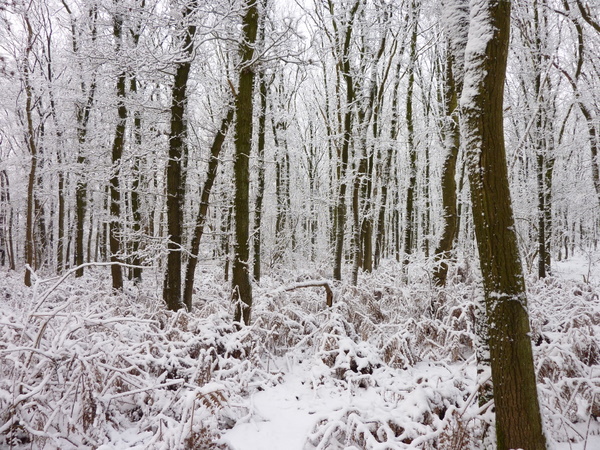 Spaartelgenbos op de Grebbeberg
Spaartelgenbos op de Grebbeberg
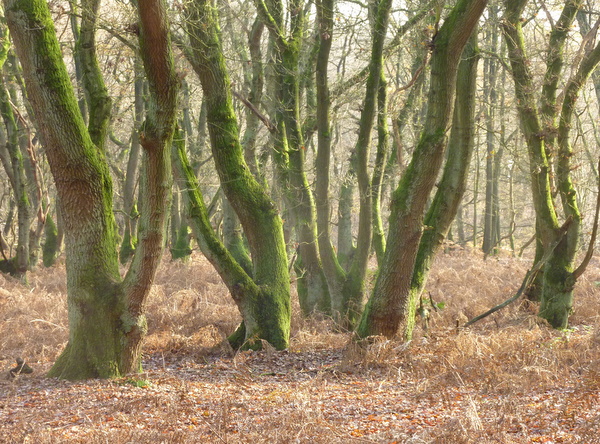 Knoteiken Grebbeberg
Foto's M.J. Kooistra:
Knoteiken Grebbeberg
Foto's M.J. Kooistra:
|
| Woodlands of the past — The excavation of wetland woods at Zwolle-Stadshagen (the Netherlands): Reconstruction of the wetland wood in its environmental context. |
|
M.J. Kooistra, L.I. Kooistra, P. van Rijn & U. Sass-Klaassen
Information on the vegetation and landscape history of a region is often limited, and available data are hard to interprete. A concept is presented here on how a more comprehensive picture of the structure and development of landscapes and vegetations of the past can be gained by integrating the information of several disciplines. Archaeological field methods have been combined with methods used in landscape studies (geology, soil science, micromorphology) and vegetation studies (ecology, palynology and dendrochronology). This concept has been applied and tested during an integrated study of a buried woodland at Zwolle-Stadshagen (Province of Overijssel, the Netherlands). Many large wood remnants were found in a peat layer preserved below a thick clay deposit. The wood remnants were dated by using dendrochronology to the period between ca. 150 BC and AD 580 (ca. 2200 - 1400 cal. BP). Two phases could be distinguished in the development of the peat. The woodland consisted of a closed stand with ash, alder and oak as main species, in the first phase mostly resembling an alder carr, and in the second one the near-extinct Filipendulo-Alnetum Passage et Hofmann 1968. No evidence of exploitation of the woodland by man nor of animal foraging was found. The followed integrated procedure has led to a more substantiated reconstruction of the palaeo-environment with its wetland wood, but also of the influence of human activities on the palaeo-landscape and its woodlands, that could not have been obtained otherwise. 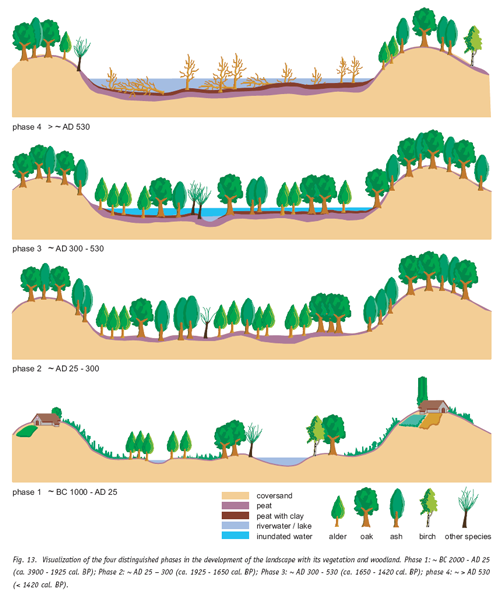
>> Complete artikel (uitgever) |
